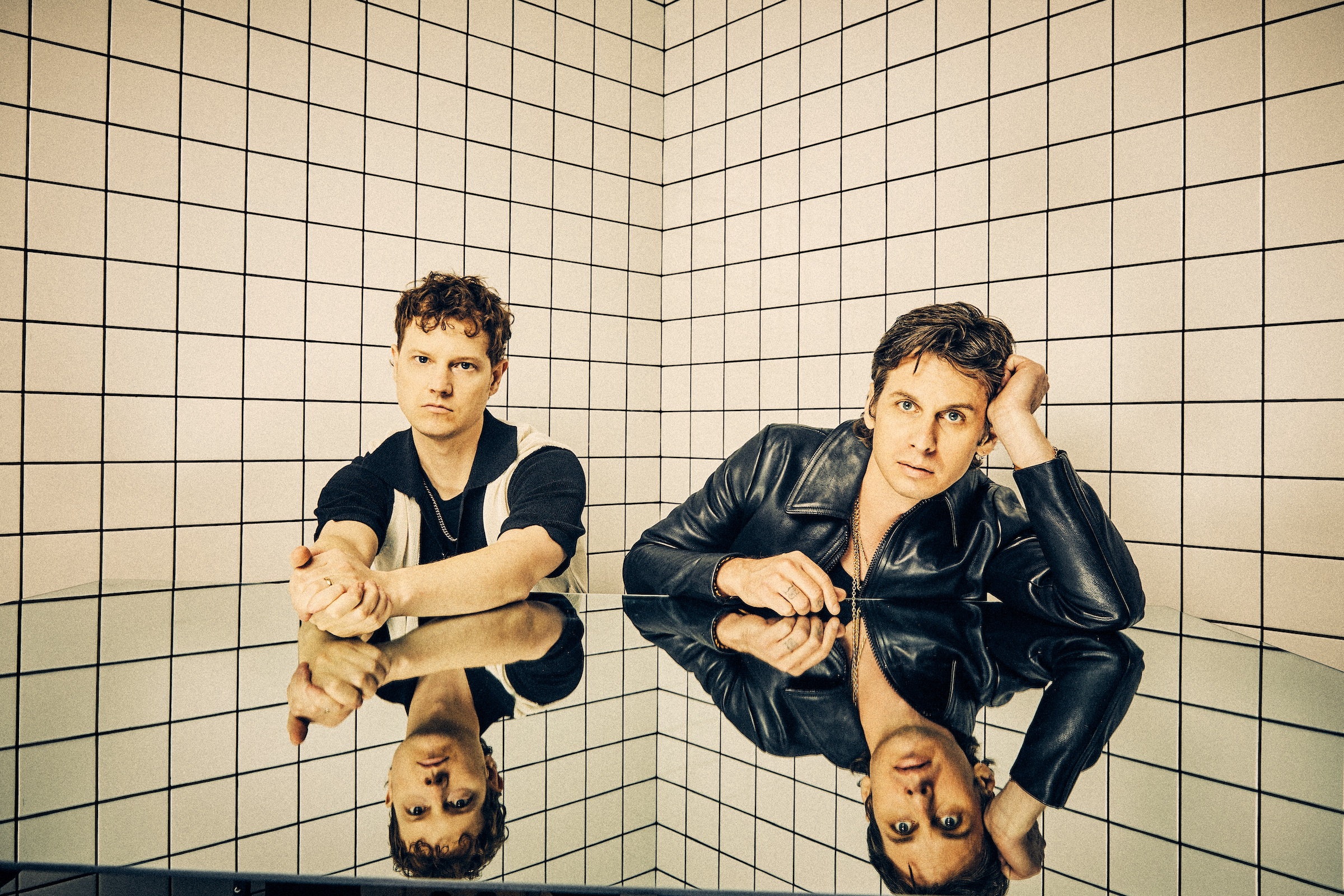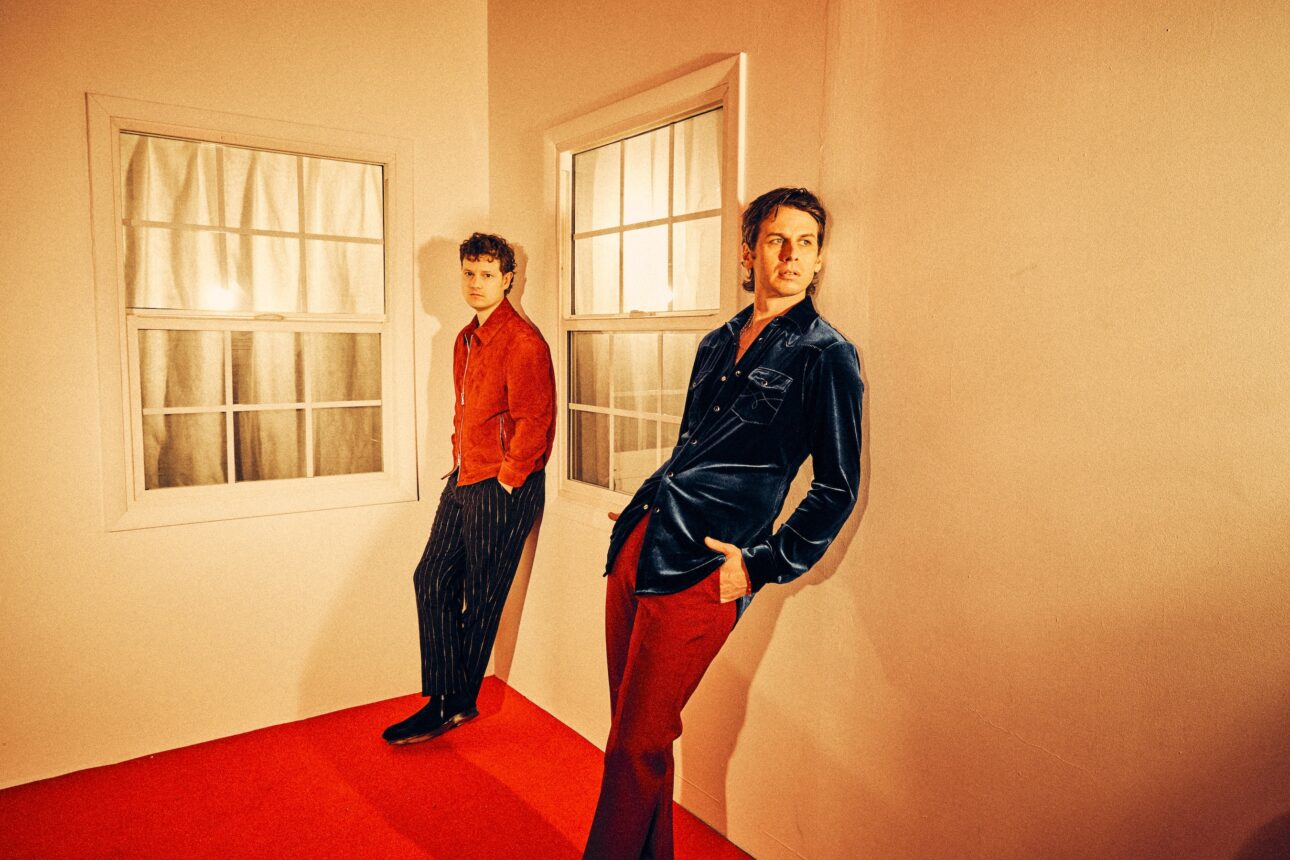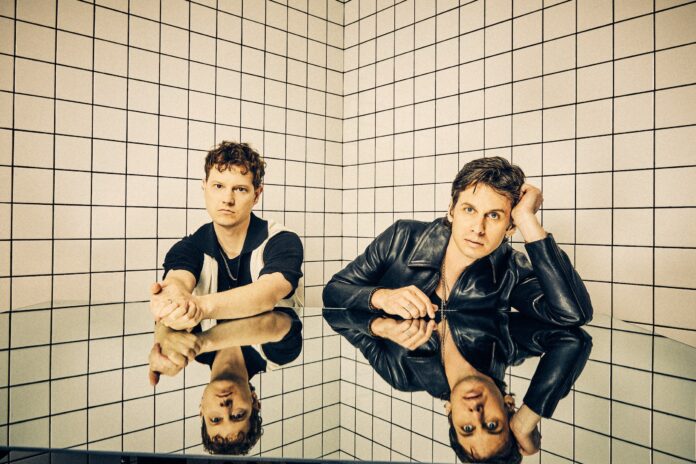
More from Spin:
- Charles R. Cross, Kurt Cobain And Jimi Hendrix Biographer, Dies At 67
- Every Van Halen Album, Ranked
- Dead Fingers Talk: Our 1987 Jerry Garcia Interview
Mark Foster’s wallpaper is distracting, in a good way. It’s a dusty rose with green palm fronds stamped at regular intervals. A dark-green tufted couch is pushed up against it with Foster’s cute dog napping on it, snoring intermittently. Nile Rodgers sat on this very same couch when he came to listen to Foster the People’s new album, Paradise State of Mind, Foster tells me. His shirt matches the couch, and multiple chains are around his neck. Other than in glamor shots on the red carpet with his multiple-award-winning wife, actress Julia Garner, I haven’t seen Foster in some time. His social media is a void. He looks younger, and he seems happy, if a little nervous.
Within the first four minutes, Foster has a word purge about Paradise State of Mind, sobriety, Paul Epworth’s The Church Studios in London, the Pet Sounds room of EastWest Studios in Los Angeles, and politics. From what I can gather, Foster took some time away from making music. “As an artist, it’s so important for me to step away and fill the well back up with life,” he says. “All the ingredients and experiences that go in, [they] end up becoming the things that inform whatever comes back out after processing and letting them blend together.”

After a protracted break, partially due to the pandemic, Foster accompanied Garner to London, where she was filming. He took some of his instruments with him and called up Epworth, who had his production fingers on the first two Foster the People albums, Torches and Supermodel. Foster went to The Church, and with Jack Peñate they wrote “Paradise State of Mind” in a day. He worked on music at The Church every day. When he came back to Los Angeles, Foster took over Room 3 at EastWest and finished the record with a host of musicians, including his musical right and left arm: Isom Innis and Sean Cimino (who has since left Foster the People).
Paradise State of Mind is heavily informed by the ‘70s, hence Rodgers’ input. As such, it is 90% analog, according to Foster. Surveying the songs with serious lyrical content and fun, danceable music, he uses the analogy of a “Trojan horse.” “My most joyful music is not a reflection of a happy person,” says Foster. “It’s therapy, trying to pull myself out of a bad mood in defiance. The music is the hope, and the lyrics are the cerebral take on something that might be darker or harder to swallow. The paradox of that is what makes it interesting to me.”
Foster has a self-realized perspective because, over the last dozen years, he’s put himself through the wringer and lived through it. Here, he talks about his experience reconciling himself as a creative, a recovering addict, and a fallible human being, in his own words.
Is This the End?
I had social atrophy from being indoors for two years, borderline agoraphobic. I was really in my head. With my identity tied to music and being in a band, then Mark Pontius leaving the band, I was like, “Is this the end? Is the universe telling me it’s time to hang it up and do something else?” When you become successful as an artist, the whole world is saying, “You have the best life. You’re so lucky.” It’s true. I am really lucky. But at the same time, that doesn’t mean I have to do this forever. There are other things I’m curious about exploring.
I started screenwriting and woodworking. I liked the simplicity of my life. But then the feeling started to emerge, that undeniable thing that every artist is blessed and cursed by: a compulsion to express. Once you’re born to be an artist, you’re going to be really uncomfortable if you walk away from it. You’re kind of fucked.
What I Do Versus Who I Am
What I do isn’t who I am. I don’t need to rely on the results of what I create as an artist for my value as a person. If it doesn’t work, that doesn’t mean I’m not loved. Everybody has a little kid in the sandbox inside of them, wanting to be accepted. It comes down to the feelings of, “Do people like me? Am I connected? Did I just say something weird?” Diving into the early formative years is going to be a lifelong process, but it gave me a couple inches of breathing room to have a bit of clarity, which allowed me to be open to this new experience of making another record and stepping back out on stage.
Balance
Trying to find a balance is a theme in my life. That goes into sobriety too, which is not being super high, not being super low, just being okay with understanding what I associated with feeling bored is actually peace, and allowing myself to be at peace. If nothing’s going on today, instead of looking at that as like a negative thing, looking at simple things in life through a different lens.
It’s taken years to reset. I don’t know if it’s the chicken or the egg with performers. We’re addicted to dopamine and adrenaline, which is why we become performers. Or it’s some exponential thing that happens when you start performing that starts to feed the desire for more. When you reach the peaks of the feeling, it becomes really hard to come down. When I create a song out of nothing and I’m the only one in the world that’s heard it and I’ve got the speakers blasting and I’m dancing in my studio, or the feeling of coming off stage, the roar and the energy coming back, that’s also tied to addiction.
After Torches
After the success of Torches, it felt like we got shot out of a cannon and we weren’t ready for it. I don’t know if there’s anything in life that can prepare you to be on a stage like that and to be comfortable with fame. I guess some people are more comfortable than others. I certainly wasn’t, and I shied away from it as much as I could.
Just the thought of going into the second record, that there were people waiting for it, the pressure made me think, “What do people want from me?” and “Who am I?”
That’s a toxic thing to let into creativity. That thing scares the shit out of the little kid that lives in my heart, who, to me, is the magician. A 5-year-old doesn’t have a critic. They just express. They’ve typically never experienced pain in social settings. They’re just curious and want to explore, and their imagination runs wild. Everything is on the table, and anything’s possible. On this record, that’s the thing I really tried to nurture.

Sobriety
I was sober for five years before I made Torches. I started drinking about six months before the band broke. My drinking was fine in the beginning. Over the next four years of touring, by the end, I was in like the darkest place I had been. When I got home, I was done touring, but I wasn’t done drinking.
I got sober again for a year and a half and made Supermodel, went out on that tour, and the isolation of it was brutal. I didn’t have a sober community. I’d be going to places trying to connect with people on the road while playing this record and feeling that commercially it wasn’t connecting—which was actually my creative intention, which was probably self-destructive at the time. I wanted to make a record with no singles. But then having to live in that for the next year and a half was a different reality. It tied into my codependency with the audience. It’s so interesting how if you try to pander to your audience, or if you’re if you try to self-destruct, they’re two sides of the same coin because it has to do with identity and my relationship to how I’m being perceived.
I relapsed in the middle of that tour and was out again for four years. In my mind, I had this deep belief that I was one of those people who was damned if I do, damned if I don’t. My lot in life was I was going to be perpetually in transit from one thing to the next, but I would never truly be happy. I had a deep core belief that I had to get used to not being content. I looked at examples of artists throughout history that were addicts or alcoholics, and was like, “Okay, I guess that’s just me.” I didn’t want to get sober again because I didn’t think it was going to work for me. I didn’t think that it would solve anything.
In 2018, we got back from this long world tour for Sacred Hearts Club. When I got home, the wheels came off and I had a pretty gnarly three-week bender leading into my birthday and catching up with all my friends. Luckily, my team and my friends intervened and helped me get out of that situation and go away for a little bit and get healthy. I got back by the skin of my teeth. I was so relieved because I was in a pattern that needed to be interrupted and I wasn’t able to get out of it myself.
Love the Process, Stay Out of the Results
I needed to surrender and be open to a new experience and throw out any of the preconceived notions that I was doomed to be depressed my whole life. It changed my life. I turned my phone off for a month. I remember waking up one morning and I sat on a bench, and I felt the breeze slightly blowing and the sun was out, and it was this moment where I felt at peace. And was like, “Oh, my god, I can be happy.”
It’s so simple, but it’s so profound because it gave me hope to start walking up this gigantic mountain of unpacking the things that were underneath, the reasons why I wanted to drink in the first place, which came down to feeling uncomfortable in my own skin and not feeling like I really belonged in this world.
Even though I didn’t intend to be gone from music for six years, I now look at it as a blessing because it gave me more time to build that foundation, to have a different perspective and to live life differently. Addiction is a disease of the mind. It’s a disease of perception. Inherently underneath all of it, is fear and selfishness. Not allowing myself to be isolated because with isolation comes fear, which is a good acronym for “false evidence appearing real.”
It’s become simplified over time, where the more complex things get, the more simple I become, which is being in love with the process, staying out of the results.
Creative Rehabilitation
I had to remind myself to give space to let the little kid that lives in my heart come out to play and allow myself to be weird. I collaborated a lot on this record, but there were these moments where I would get stuck, and even though I’ve got a Rolodex of great songwriters in my phone and there was the temptation to call somebody to help me crack a verse or a chorus, instead of making that call, I talked myself through those things. It’s your point of view that makes you an artist, so trust it. If it’s weird, it’s okay. Now, when I reflect on certain times when I did that, they’re my favorite parts of the record. It was like creative rehabilitation, returning to what it felt like to make music before I knew there was an audience.
Part of that process was keeping our creative team insular. The people in the room were artists. All other voices were kept out of the room. We got away from the expectations that this record had to do anything for us. Not putting any pressure that people are going to like it, and letting the art be what it’s going to be, and having fun in the exploration, which ended up being really gratifying, even though it was a mountain to climb musically.
Art is a Safe Space
Your producer is also a psychologist, a mentor, a friend, a teacher. Paul identified early on that the block I was feeling was fear. In 2022, I didn’t know what I could say. There are so many things happening around the world, and I felt like, on the periphery, artists were being attacked for having a point of view. The underlying feeling in the air was, simply put, fascism. This omnipresent attack on independent thought if you didn’t fall in with a tribalist point of view. In our country, identity politics have become a binary point of view. You’ve got two choices of what you want to express. One side’s going to hate you, and the other side’s going to come to your defense.
That’s not what I’m interested in. The way I look at life is not these emotional knee-jerk reactions. Observing culture, thinking about where it’s going to go, thinking about where we’ve come from, and telling the story more in the middle, I felt like if I write honestly about where we’re at culturally, I’m stepping into something that feels physically dangerous. Paul reminded me what art is. He reminded me you can say anything you want. You’re safe. Art is meant to be a safe space to communicate anything, and it’s important for people to tell stories to help digest what’s going on. Paul created a safety to start expressing myself, which is funny because there’s nothing on this record that I’m afraid of, other than sharing more intimately about myself than I ever have.
To see our running list of the top 100 greatest rock stars of all time, click here.












